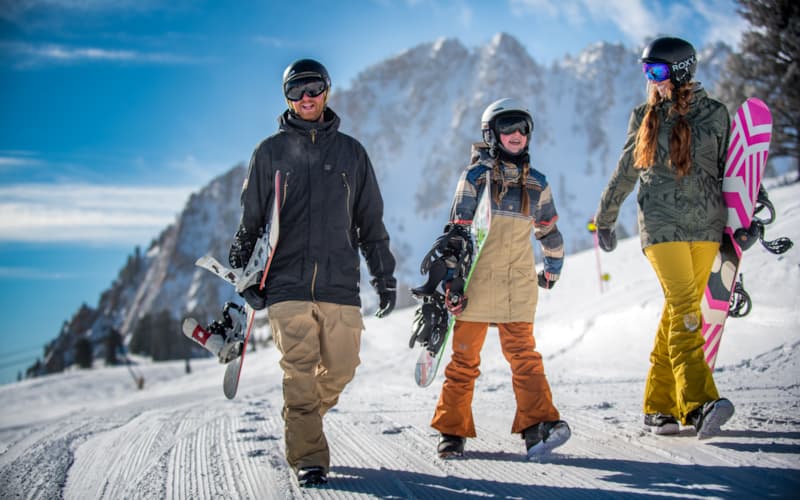It’s your first time skiing and you are unsure where to start. Whether it’s a weekend ski vacation to Snowbasin or you just moved to Utah and want to get into winter activities, we’ve got you covered.



It’s your first time skiing and you are unsure where to start. Whether it’s a weekend ski vacation to Snowbasin or you just moved to Utah and want to get into winter activities, we’ve got you covered.

Helmet: Helmets are arguably the most important piece of equipment to bring to the mountain, especially if you are new to the sport. When selecting a helmet, ensure it fits well and feels comfortable. The helmet should fit snugly on your head—if it shifts side to side or front to back when moving, you'll need to size down or tighten it.
Goggles: Ski goggles are also a crucial part of your ski outfit. When purchasing ski goggles, consider the fit and comfort (especially with your helmet on), lens tint (polarized for sunny days, clear for cloudy days), and lens technology/ventilation (to reduce or prevent condensation inside the lens).
Neck Gaiter / Balaclava: A neck gaiter or balaclava is essential for skiing in any conditions. These items help keep you warm during winter and protect your head, neck, and face from wind, low temperatures, and other elements you may encounter on the mountain.
Base Layers: Whether it's a super cold, snowy day or a warm spring day, base layers are always recommended. Pro Tip: Merino wool or synthetic thermal base layers provide the best combination of warmth and breathability.
Insulated or Shell Jacket: A ski jacket is essential for keeping you dry in any condition. You have two main options: an insulated jacket, which is ideal for colder days and requires fewer layers but may lack breathability and versatility; or a shell jacket, which offers greater breathability and versatility but may require additional layers, such as a puffer, for optimal warmth in colder weather.
Insulated or Shell Pants/Bibs: Similar to ski jackets, insulated pants or bibs keep you dry and warm without needing as many base layers but may lack breathability in warmer conditions. Shell pants or bibs offer more breathability and versatility but often require thicker base layers and more insulation in colder environments.
Ski Socks: Ski-specific socks are highly recommended for added comfort, breathability, warmth, and dryness. They can also help prevent blisters and provide better ankle and foot support than regular socks.
Mittens/Gloves: Last but not least, ski mittens or gloves are essential for keeping your hands warm and dry in all conditions. Mittens typically offer more warmth, while gloves provide greater versatility and grip.
Now that you’ve purchased the essential gear to keep you dry, warm, and safe, it's time to find equipment that best suits the activity you're trying to learn. If you're unsure where to begin, it’s a good idea to try both skiing and snowboarding. Renting equipment is highly recommended for first-timers, as it allows you to experience both sports and make an informed decision when purchasing your gear. Snowbasin offers rentals and an award-winning Learn & Earn program, which provides an 80% discount by bundling rental gear, a season pass, and three all-day lessons for your first year.
If you have already decided on purchasing your own gear, it’s important to ensure you're purchasing the right equipment.
Skiing: Ski boots, ski poles, skis, and ski bindings.
Snowboarding: Snowboard boots, snowboard, and snowboard bindings.
When buying new or used gear, make sure everything fits you properly and works well together as a whole. Avoid ski or snowboard boots that are too tight, too loose, or cause any pain points or hot spots, as these can be highly aggravating. Additionally, ensure that your skis or snowboard are compatible with the rest of your equipment, e.g., are your bindings compatible with your skis? Are your boots too big or small for your bindings? Pro Tip: If you're unsure about boot and equipment sizing or compatibility, don’t hesitate to ask questions to find the best fit for you.
Now that you’ve got all your gear situated, it’s time to explore what Snowbasin has to offer. From world-class skiing to award-winning dining, we’ve got you covered.